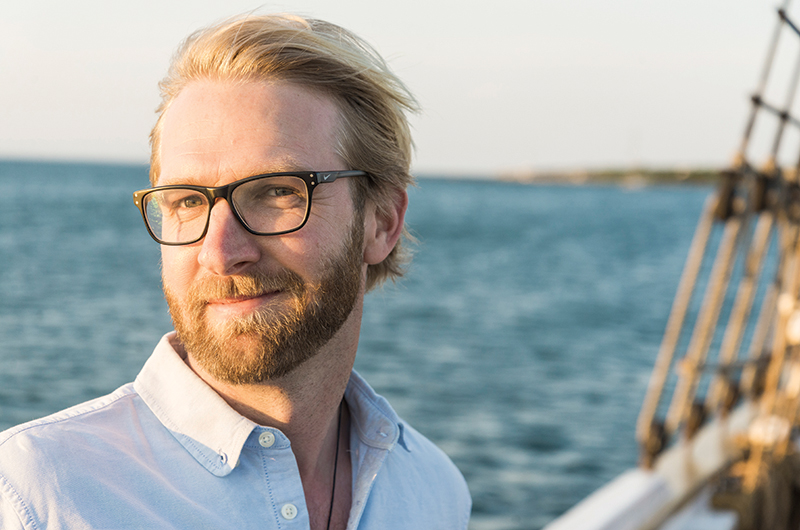There is a seaman’s expression: “He came up through the hawsepipe,” the hawsepipe being the hole in the bow of a ship through which the anchor chains run. When Ian Ridgeway first encountered the topsail schooner Shenandoah, he very well may have been able to fit through the hawsepipe. Slight of build, with blonde hair and an enthusiasm that is undeniable, he describes himself as the Shenandoah’s first stowaway – which he may have been. He came aboard with a fifth grade class for a week-long trip, after which he called his mom to tell her the captain had invited him on board for another week. That wasn’t the case, but when Captain Robert Douglas discovered the ruse, he allowed young Ridgeway to stay on, having taken a liking to the boy. There was a free bunk and a position he could fill – that of galley boy.
The Shenandoah has a long tradition of moving folks up through the ranks, starting with the position of galley boy. If you proved your worth there – a job not for the faint of heart – you could earn a berth in the fo’c’sle as a humble deckhand. If one kept at it as a deckhand, the next rung on the ladder, or “up the ratlines” in ship parlance, was bosun. The bosun’s job is to keep all the various parts of the rig in order, as well as to make sure that all the running rigging, blocks, and tackles are in good shape. Following bosun is the position of second mate, and after that the prized position of first mate, who is second only to the captain and equal only to the cook.
In the subsequent years Ridgeway fulfilled all the requirements and climbed the ratlines, even going beyond the position of mate to become a captain of the Shenandoah’s sister ship, the Alabama. His rise was by no means meteoric. It took years of hard work. But it was this journey through the ranks – all the learning, dedication, and adventure, which leads to a deeper understanding of life – that led him to embark on a new journey and pick up Douglas’s long-deferred dream of building a steel schooner by the lines of the Shenandoah.
A half-century ago, when Douglas had the idea of building a nineteenth-century topsail schooner and the Shenandoah was born, his plan was to carry passengers up and down the East Coast. After a few years, however, it became evident that adult passengers prefer amenities and deadlines met rather than the whims of tide and weather: the Shenandoah has no engine with which to buck the tide, only a coal-fired stove in the galley, kerosene lanterns, and a tight berth. The work of all the passengers is required to heave on the lines to hoist the sails.
As the number of adult passengers dwindled, Douglas began to bring on board children from the local schools. Slowly, kids’ cruises became the norm. Though the trips weren’t listed as educational, they were inherently so. At some point Douglas decided he wanted to build a new schooner from the plans he had drafted for the Shenandoah, but this time it would be made of steel and would include an engine, maybe even hot water.
It is this vision that Ridgeway has revived and expanded upon. Along with Captain Casey Blum, the first women skipper for The Black Dog Tall Ships, he has created a nonprofit called Foundation for Underway Experiential Learning, or FUEL, with the goal of raising nearly $5 million to build and endow the new ship. It’s a heavy lift on an Island filled with good causes, to be sure. But with an impressive board of directors and volunteer consultants from the world of sailing education, and Ridgeway’s seemingly unbounded supply of energy and enthusiasm, the day will no doubt come when the champagne bottle will be broken on the bow and the new vessel will slide down the ways into the sea.
Then the young sailors will experience packing their bags and climbing aboard, finding their bunks and meeting their shipmates. The lines will be let go, the sails will be set, and in a matter of hours they will be out of sight of land and far beyond the reach of WiFi. As they journey and do their appointed tasks – taking classes, helping in the galley, standing watches, swabbing decks – they will discover other things: that they can withstand the storms and calms alike, that they can live in tight quarters and learn to get along. They will discover the joys of navigation, sail handling, and all of the necessary skills of the sailor. They will discover themselves.
They will see things only seen at sea by mariners: hundreds of dolphins approaching from all directions as if on cue and then departing with no notice, sunrises and sunsets, stars and moon seen as never before. They will see other ships and meet other crews, but perhaps most importantly, they will test themselves and discover they are able-bodied, and will become more sound of mind and spirit. And they will dream the dreams of sailors at sea.





